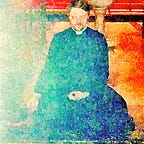Today the Church remembers Saint Ansgar (8 September 801 — 3 February 865 AD), who was Archbishop of Hamburg-Bremen in the northern part of the Kingdom of the East Franks. Ansgar became known as the “Apostle of the North” because of his travels and the See of Hamburg received the missionary mandate to bring Christianity to Northern Europe.
Ora pro nobis.
Ansgar was the son of a noble Frankish family, born near Amiens. After his mother’s early death, Ansgar was brought up in Corbie Abbey, and was educated at the Benedictine monastery in Picardy. According to the Vita Ansgarii (“Life of Ansgar”), when the little boy learned in a vision that his mother was in the company of Saint Mary, his careless attitude toward spiritual matters changed to seriousness. His pupil, successor, and eventual biographer Rimbert considered the visions (of which this was the first) to have been Ansgar’s main life motivator.
Ansgar was a product of the phase of Christianization of Saxony (present day Northern Germany) begun by Charlemagne and continued by his son and successor, Louis the Pious. In 822 AD, Ansgar became one of many missionaries sent to found the abbey of Corvey (New Corbie) in Westphalia, where he became a teacher and preacher. A group of monks including Ansgar were sent further north to Jutland with the king Harald Klak, who had received baptism during his exile. With Harald’s downfall in 827 and Ansgar’s companion Autbert having died, their school for the sons of courtiers closed and Ansgar returned to Germany. Then in 829, after the Swedish king Björn at Hauge requested missionaries for his Swedes, King Louis sent Ansgar, now accompanied by friar Witmar from New Corbie as his assistant. Ansgar preached and made converts, particularly during six months at Birka, on Lake Mälaren, where the wealthy widow Mor Frideborg extended hospitality. Ansgar organized a small congregation with her and the king’s steward, Hergeir, as its most prominent members.
In 831 Ansgar returned to Louis’ court at Worms and was appointed to the Archbishopric of Bremen. This was a new archbishopric, combining the bishoprics of Bremen and Verden and with the right to send missions into all the northern lands, as well as to consecrate bishops for them. Ansgar received the mission of evangelizing pagan Denmark, Norway and Sweden. The King of Sweden decided to cast lots as to whether to admit the Christian missionaries into his kingdom. Ansgar recommended the issue to the care of God, and the lot was favorable.
Ansgar was consecrated as a bishop in November 831, with the approval of Gregory IV. Before traveling north once again, Ansgar traveled to Rome to receive the pallium directly from the pope’s hands, and was formally named legate for the northern lands. Ebbo, Archbishop of Reims had previously received a similar commission, but would be deposed twice before his death in 851, and never actually traveled so far north, so the jurisdiction was divided by agreement, with Ebbo retaining Sweden for himself. For a time Ansgar devoted himself to the needs of his own diocese, which was still missionary territory and had few churches. He founded a monastery and a school in Hamburg. Although intended to serve the Danish mission further north, it accomplished little.
After Louis the Pious died in 840, his empire was divided and Ansgar lost the abbey of Turholt, which Louis had given to endow Ansgar’s work. Then in 845, the Danes unexpectedly raided Hamburg, destroying all the church’s treasures and books. Ansgar now had neither see nor revenue, and many helpers deserted him. The new king, Louis’ third son, Louis the German, did not re-endow Turholt to Ansgar, but in 847 he named the missionary to the vacant diocese of Bremen, where Ansgar moved in 848. However, since Bremen had been suffragan to the Bishop of Cologne, combining the sees of Bremen and Hamburg presented canonical difficulties. After prolonged negotiations, Pope Nicholas I would approve the union of the two dioceses in 864.
Through this political turmoil, Ansgar continued his northern mission. The Danish civil war compelled him to establish good relations with two kings, Horik the Elder and his son, Horik II. Both assisted him until his death; Ansgar was able to secure permission to build a church in Sleswick north of Hamburg and recognition of Christianity as a tolerated religion. Ansgar did not forget the Swedish mission, and spent two years there in person (848 — 850 AD), averting a threatened pagan reaction. In 854, Ansgar returned to Sweden when king Olof ruled in Birka. According to Rimbert, he was well disposed to Christianity. On a Viking raid to Apuole (current village in Lithuania) in Courland, the Swedes plundered the Curonians.
Ansgar was buried in Bremen in 865 AD. His successor as archbishop, Rimbert, wrote the Vita Ansgarii. He noted that Ansgar wore a rough hair shirt, lived on bread and water, and showed great charity to the poor. Pope Nicholas I declared Ansgar a saint shortly after the missionary’s death. The first actual missionary in Sweden and the Nordic countries (and organizer of the Catholic church therein), Ansgar was later declared “Patron of Scandinavia”.
Almighty and everlasting God, you sent your servant Anskar as an apostle to the people of Scandinavia, and enabled him to lay a firm foundation for their conversion, though he did not see the results of his labors: Keep your Church from discouragement in the day of small things, knowing that when you have begun a good work you will bring it to a fruitful conclusion; through Jesus Christ our Lord, who lives and reigns with you and the Holy Spirit, one God, for ever and ever.
Amen.
